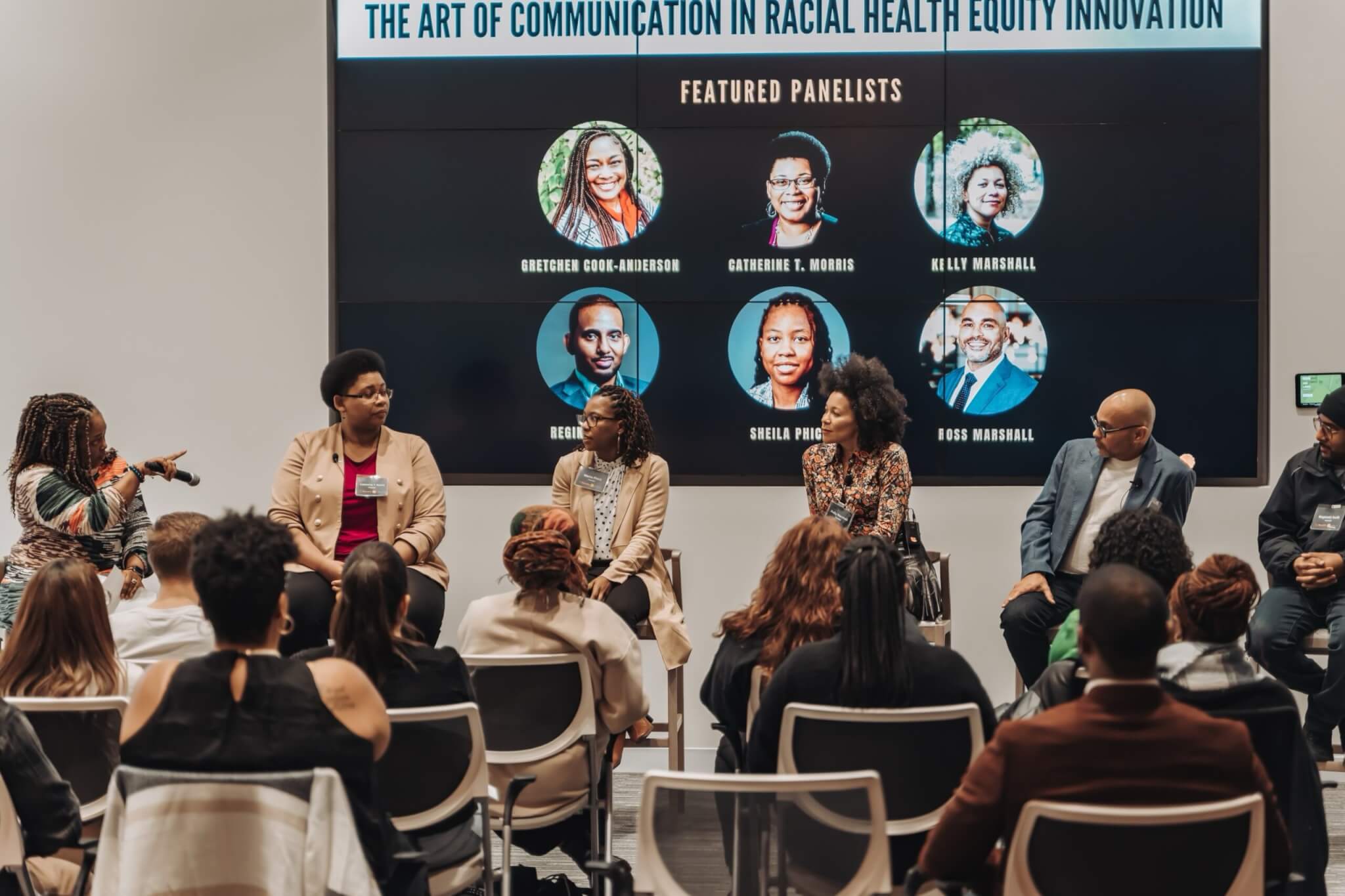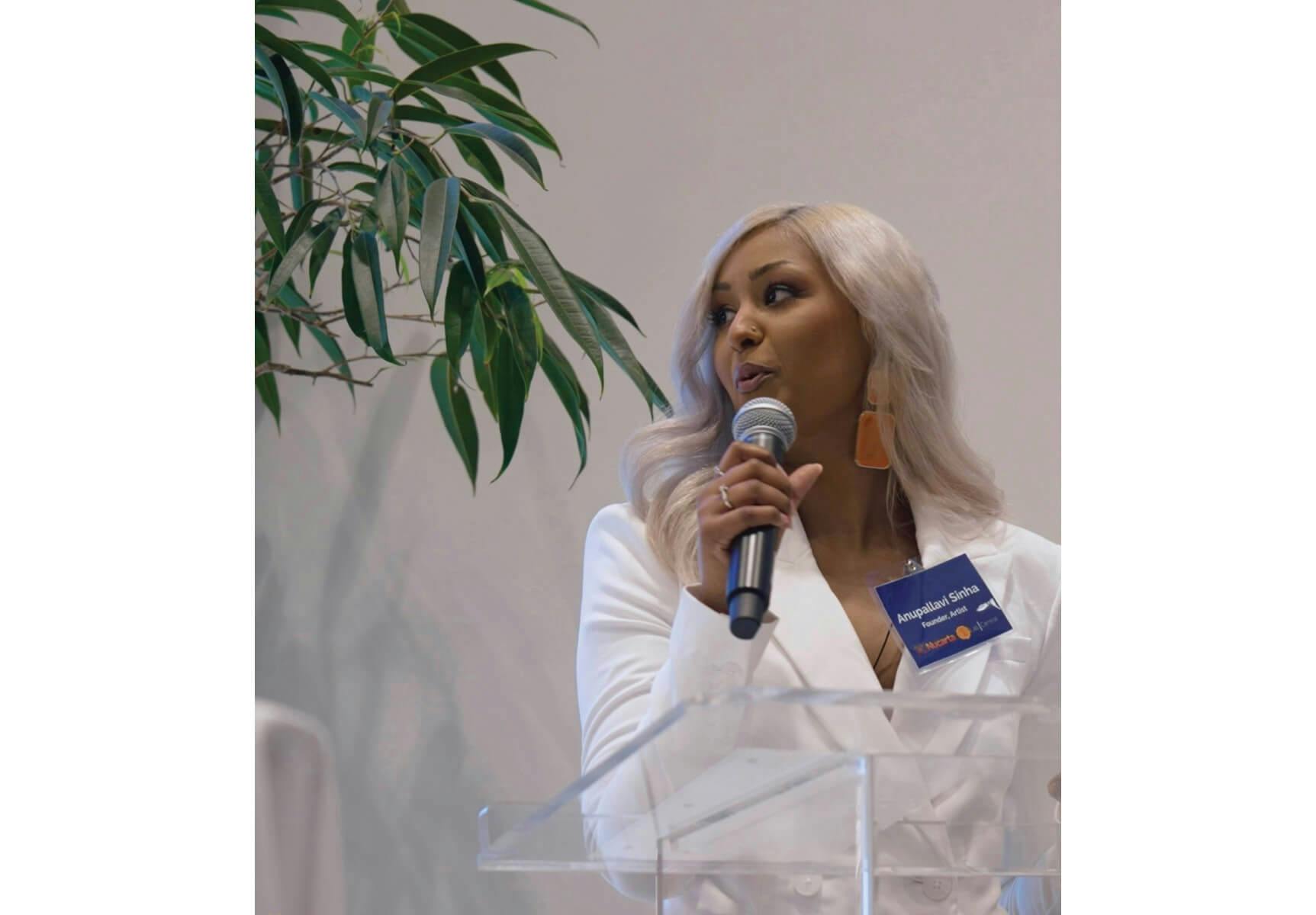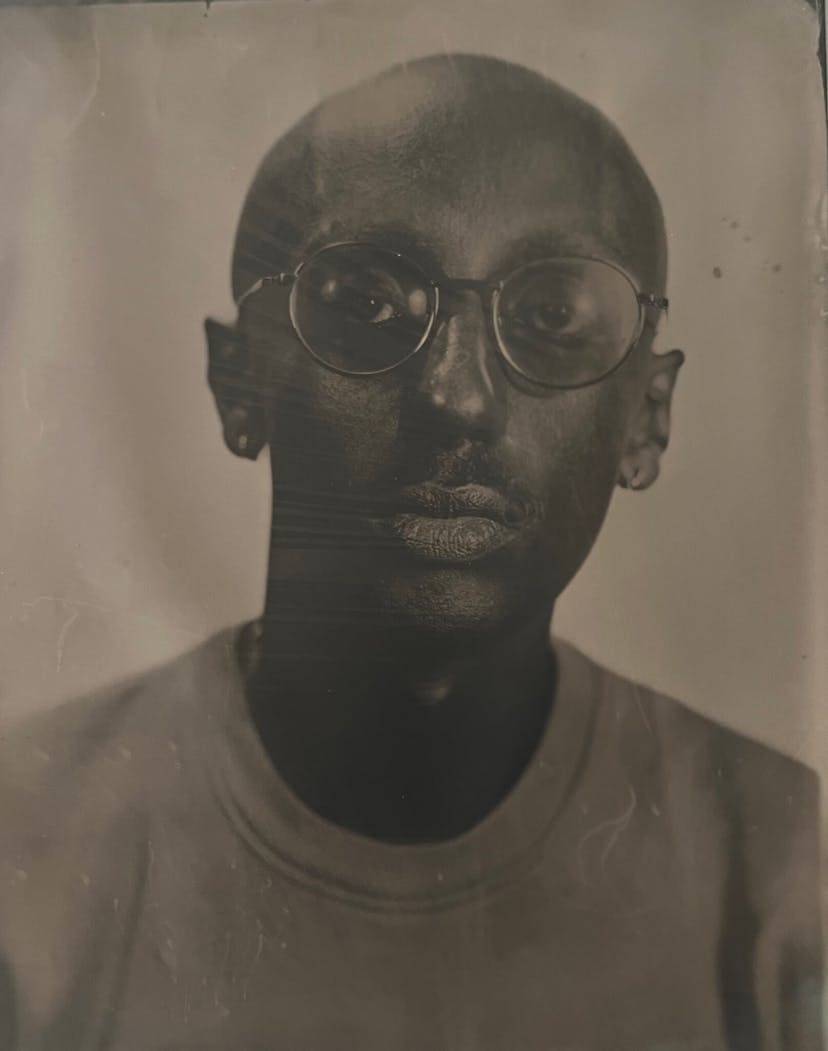The cross-streets where biotech and contemporary art intersect are few and far between, but Anupallavi Sinha, a Boston-based health researcher and multimodal creator, is leading the charge in making those linkages. In February of 2023, Sinha invited a group of artists and executives—including key leaders like Catherine Morris of the Boston Foundation and BAMS (Boston Art & Music Soul) Fest and Ross Marshall of MassBio and Blacks in Bio—to discuss the role of creativity in health innovation. This panel discussion marked the launch of Nucarta, a racial health equity and arts advocacy organization led by Sinha. The February program at LabCentral in Kendall Square accompanied Nucarta’s premier exhibition titled “The Art of Communication in Racial Health Equity Innovation,” which showed work by David Edmundson, Ananda Toulon, Cesar Perez, Malia Setalsingh, and Sinha herself.
Nucarta’s next exhibition is “Multiplicities: An Artistic Exploration of Racial Disparities in Cancer Outcomes,” which will be on view at MIT’s Koch Institute Public Galleries through December 8. Kicking off with an opening reception on September 28 and a Cambridge Science Festival program on September 29, the show features work by Bianca Rose, Ifé Franklin, Nygel Jones, Ryan Horton, and Stanley Rameau and contemplates how “the burden of cancer multiplies beyond the individual, impacting [Black and brown] families, communities, and society as a whole.”
I spoke with Sinha in March and August to catch up with her vis-à-vis Nucarta’s launch and the organization’s trajectory in its first year.
Alula Hunsen: How would you describe your relationship with Boston, with the arts, and with health?
Anupallavi Sinha: I grew up in Canada. I always visited family in the Boston area, but it was only recently that I made the decision to move. I found that Boston had more opportunities and flexibility to pursue my creative interests and the scientific innovation field. Boston is a fertile ground for people with new ideas to come and try them out. The sense of community that I felt when I finally found my tribe, after taking a more intentional approach with seeking out authentic connections, was life changing.
In today’s terms, health equity is defined as the state in which everyone has a fair and just opportunity to attain their highest level of health. And as we know, there’s so much research evidence to demonstrate that this is simply not the case for Black and brown racial and ethnic minority communities, especially in Boston. And this is no new phenomenon, right? These disparities have been documented for decades.
As soon as I became more actively involved in the arts space in Boston, I saw the disparities there too: Black and brown artists are not given the same platforms. So outside of the health advocacy piece for Nucarta, I felt very strongly about empowering artists of color by creating more opportunities for them to showcase and sell their work.
AH: How would you characterize yourself as a founder and CEO and Nucarta as a new organization?
AS: I love to define myself as a “creative solutioner,” a term that we’ve coined at Nucarta. Our mission is to creatively “solution” for racial health, equity, and justice by proactively connecting the scientific innovation, public health, and art fields. The goal here is to ultimately achieve improved health outcomes for our Black and brown, racial, and ethnic minority communities. I feel very passionately about pushing this work forward with intentionality. And I have no choice really as a woman of color but to bring a DEI-focused lens to my research work.
AH: I love how you explain “solutioning” on your website, saying, “We have made the deliberate choice to verbify the word ‘solution’ to emphasize that there is no one-size-fits-all solution that can eliminate all disparities.” What does creative solutioning look like for Nucarta? And what does this melding of creativity into health equity look like? Especially because typically, creativity in the sciences looks like technological advancement or implementation. But there’s a lot more going on under Nucarta’s umbrella.
AS: We have identified three areas for which health equity innovation gaps currently exist: creativity, communication, and community engagement. You don’t see too many people in the science or biotech fields talking about art and how it can facilitate empathy, how art can humanize health research and be a means of community engagement. And so with our launch exhibition, we wanted to challenge the people in the room—creatives, scientists, healthcare providers, innovators, and observers and art enthusiasts in general—to think about and to reevaluate their roles and their responsibilities in combating structural and systemic racism that is so deeply embedded in today’s life sciences ecosystem.
In our early stages, we are aiming to make an impact in not only the health equity space, but also the art spaces by facilitating impactful and intentional conversations and creating a platform for artists. We hope to extend artists’ reach into the health field. Innovation, in its truest essence, means to create something new. How do we plan on creating without creatives? We can’t expect change by implementing the same solutions. We need artists in this conversation, and we are only looking to work with organizations who are willing to support the artists. What that looks like is gallery spaces agreeing to let 100 percent of the sales go to the artists.

Nucarta’s launch event included a panel discussion led by Gretchen Cook-Anderson of LabCentral. From left to right: Gretchen Cook-Anderson, Catherine T. Morris, Sheila Phicil, Kelly Marshall, Ross Marshall, and Reginald Swift. Photo courtesy of AVARIA. Photo by Daron English.
AH: How did the kickoff event come together, and what was the community response that you felt from it?
AS: It started with the artwork. I first wanted to follow up on the momentum that resulted from a pop-up exhibition that artist Retrospacely and I held last year at SubCentral in Cambridge called “The Rebel’s Algorithm.” People were asking for part two. And as I was getting deeper into preparation for this startup, I started trying to understand who are the key stakeholders in Boston that are making strides forward in the health and art worlds. I asked, who do we feel like we can bring together to have the most impact in both of these spaces? Through a series of informational interviews with stakeholders, we created a cross-industry panel discussion and Q&A.
The thoughtful questions we received from the community, the attendees, showed that our communities are interested in participating in this conversation—we just need to create space for it to happen. It was fantastic to have creative energy in the room, as well as technical minds who were interested in the similarity between creative thinking and analytical thinking, and how someone’s artistic ability can help their research.
AH: What specifically within the public health and health disparity arenas will Nucarta seek to address?
AS: I’m particularly interested in the drug development and the medical device space, and I work in drug discovery. This is more long term for Nucarta, but the lack of clinical trial diversity is a problem that we need to address now. We must encourage diversity among both researchers and the participants in these early stages, because increasing representation in clinical trials ensures that the medicines and medical devices that are being developed are actually effective for us.
The way that we’re looking at stakeholders in the health equity conversation is threefold: there is the scientific innovation field, which are the people who are creating our medicines and diagnostic devices, the public health field, which are the people who are providing our medicines to our communities, and there are artists, who are both key change agents and representatives of our communities who will be receiving our medicines. All of these spaces must be communicating with each other in order to transform our health systems. So it’s less so an approach to a specific disease research sphere and more so an overarching master connector, if you will. Nucarta is hoping to create a bridge between these three different spaces by pushing for more collaboration.

Installation view, “The Art of Communication in Racial Health Equity Innovation,” LabCentral, Cambridge. On view February 16, 2023, through April 25, 2023. Photo courtesy of LabCentral.
AH: What will community engagement look like for Nucarta? Will it continue to look like organizing exhibitions and events, or are there different outlets and opportunities for connecting with folks?
AS: That’s a question that we’ve been thinking very deeply about, because you do have to sort of define yourself in the early startup stages. I’m realizing that what we’re pursuing at Nucarta doesn’t perfectly fit into any of the startup categories. It’s community building in the art space, but it’s also community building in the public health and biotech space.
So the types of productions, if you will, that we’re hosting in these early stages are more so networking, community-based events where we’re bringing in scientists to observe art that’s created on relevant topics and to prompt further thinking on these ideas, but also have these opportunities be leveraged by artists as opportunities to show their work. It’s a learning experience for all, and it’s also a vibe. We hope to raise awareness about the variety of career opportunities in the health field to get more people who look like us into these spaces.
We also want to ensure that we’re fueling the education and training of researchers and healthcare providers on things like cultural sensitivity and social determinants of health in order to understand how racism and other forms of discrimination are actually affecting the health of our communities. This is something that we’re having conversations about with schools around the city to determine the framework that we can put forward that might help plant seeds in different students—whether in medical school or public health programs, whether they’re high school students or in an art organization. We’re interested in implementing programs that get people thinking about opportunities in the health equity space, and we are bringing artists into these conversations to show students the power of combining art, science, and health practices.
AH: What do you foresee as some of the challenges that Nucarta will face?
AS: Something we’re facing at the moment is that we are trying to be intentional with who we’re working with; I feel very strongly about working with Black, brown, and minority folk in both spaces to push this work forward. We should be leading the racial health equity movement. And we have received some pushback that this is not an inclusive approach: that it might hold us back and take us longer to achieve what we’re trying to achieve, because generational wealth lives in different communities. We’ve taken this feedback, but it was almost a no-brainer. We’re willing to do whatever we need to do to do it this way.
AH: Pardon the potentially poor analogy, but is it fair to say Nucarta is a sort of connective tissue that is looking to facilitate movement?
AS: I would absolutely say so. Nucarta is a movement, because you’ll see a lot of advocacy efforts that aren’t directly translating to change. We want to ensure that we’re taking things a step further from having conversations. It doesn’t just stop at the art exhibition and it doesn’t just stop at a panel discussion. It’s that now we’re following through with all those involved and ensuring that it’s leading to some sort of measurable impact. And it’s been exciting to explore what those things might be from the launch exhibition, as well as what might come out of the fall exhibition and other opportunities. We aim to be a master connector to prompt action and change.
“Multiplicities: An Artistic Exploration of Racial Disparities in Cancer Outcomes,” will be on view at MIT’s Koch Institute Public Galleries through December 8. Join Nucarta for the opening reception on September 28, including a DJ, artist talks, and mingling across the arts and sciences, followed by a Cambridge Science Festival program on September 29.



